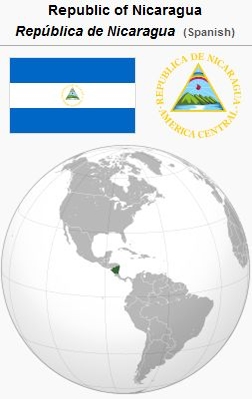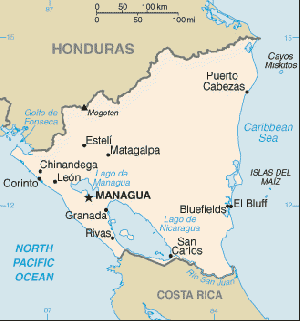Nicaragua
Introduction
The Republic of Nicaragua is the largest country in Central America with an area of 130,373 km2 (50,193 square miles). The country is bordered by Honduras to the north and Costa Rica to the south. The Pacific Ocean lies to the west of the country, the Caribbean Sea to the east. The capital city of Nicaragua is Managua.
The estimated population in July 2009 was 5,891,199. Recent statistics state that the country's population is 69% mestizo (people of mixed European and Amerindian heritage), 17% white, 5% amerindian, and 9.0% black and other races.
The 2005 Nicaraguan census stated the religious affiliations of the Nicaraguan population as follows: Roman Catholic 58.5%, Evangelical 21.6%, Moravian 1.6%, Jehovah's Witnesses 0.9%, Irreligious 15.7%, and Other (including Buddhism, Islam, and Judaism) 1.6%. In 1987 the population was approximately 80% Roman Catholic.
1990 Article

The work of the three Anabaptist-rooted denominations, the Brethren in Christ, the Conservative Mennonite Conference and the Evangelical Mennonite Conference (Kleine Gemeinde, Manitoba), has followed a similar pattern. All three began work in the 1960s. As the work grew, more missionaries were sent out. Three extraordinary events influenced their work: the 1972 earthquake that destroyed much of Managua (the capital city), the Sandinista overthrow of the Somoza government (1978-79), and the Unites States-Nicaragua clash (1982ff.).
The results of the revolution and clash were that most of the missionaries returned to North America and those remaining gave themselves almost exclusively to pastoral and leadership training. Actual leadership and administration of the churches was given over to Nicaraguans. In addition, although life was subject to disruption by the strife, the events made many Nicaraguans receptive to the gospel. Because of religious motivation and political factors, churches gave attention to social and economic problems.
War and militarization have focused the matter of conscientious objection to war. Discussions with the government have resulted in draft exemption for pastors and seminary students but not for lay people. Mennonite and Brethren in Christ men have responded in different ways. Some have served in the army, some have on the local level secured noncombatant work within the army through arrangements with their superiors, some have hidden, and some have fled.
The Iglesia Hermanos en Cristo (Brethren in Christ Church) began its work in 1964 in the Managua area. After a few years the work gained momentum so that by 1985 there were 54 congregations located in 9 of the 16 provinces (departments) with a total membership of 1,794. In 2003 there were 3,775 members in 68 congregations. From the beginning the Brethren in Christ approach was to train and use national leaders. The church was organized on a national level as the Iglesia Hermanos en Cristo, Nicaragua.
The Conservative Mennonite Conference (MC) began in 1968 with a large voluntary service program. The first missionaries arrived in 1973 and within a few years a national conference of the congregations was organized under the name Convención de las Iglesia Evangélicas Menonitas de Nicaragua (Conference of Evangelical Mennonite Churches in Nicaragua). In 1986 the conference consisted of 30 congregations and mission locations with 780 members. In 2003 there were 4,300 members in 80 congregations. Some 80 members were in refugee camps in Costa Rica because of the fighting.
The missionary work of the Evangelical Mennonite Conference began in 1966. In 1986 the outgrowth of this work was known as Fraternidad de las Iglesias Evangélicas Menonitas de Nicaragua (Brotherhood of Evangelical Mennonite Churches, Nicaragua). It was active in seven provinces, had organized six congregations and established eight preaching points. Membership in these congregations was 300. In 2003 there were 1,200 members in 28 congregations.
The Mennonite Central Committee (MCC) responded to the acute needs following the 1972 Managua earthquake. In that context the Evangelical Committee for Aid and Development (CEPAD) was formed and MCC worked with it in relief and housing construction programs. All three Mennonite-related conferences mentioned above belong to CEPAD. MCC returned in 1979 following the deposing of Somoza and again assisted in reconstruction work, largely through CEPAD. In 1986 MCC had five workers in the country engaged in three types of work: supplying large amounts of food for people displaced by war, working with the three Mennonite-related conferences in rural development activities, and lending two people to the Ministry of Agrarian Reform to help in designing and constructing irrigation systems. MCC was also concerned to encourage peace, and was seeking to help North American Mennonites and Brethren in Christ to better understand developments in Nicaragua. -- Donald R. Zook and Martin H. Schrag
2010 Update
In 2009 the following Anabaptist denominations were active in Nicaragua:
| Denomination | Congregations | Members |
|---|---|---|
| Asociación Misión Evangélica de los Hermanos en Cristo en Nicaragua | 114 | 3,915 |
| Beachy Amish Church | 6 | 91 |
| Convención de Iglesias Evangélicas Menonitas de Nicaragua | 106 | 5,151 |
| Fraternidad de Iglesias Evangélicas Menonitas de Nicaragua | 32 | 2,150 |
| Independent & Unaffiliated | 3 | 35 |
| Total | 261 | 11,342 |
Bibliography
Kraybill, Paul N., ed. Mennonite World Handbook. Lombard, IL: Mennonite World Conference, 1978: 233-238.
MCC Workbook (1986).
Mennonite World Handbook Supplement. Strasbourg, France, and Lombard, IL: Mennonite World Conference, 1984: 89-91.
Mennonite World Conference. "Mennonite and Brethren in Christ Churches Worldwide, 2009: Latin America & The Caribbean." 2010. Web. 28 October 2010. http://www.mwc-cmm.org/en15/files/Members 2009/Latin America & the Caribbean Summary.doc.
Mennonite World Conference. "MWC - 2003 Caribbean, Central & South America Mennonite & Brethren in Christ Churches." Web. 7 May 2006. http://www.mwc-cmm.org/Directory/carcsam.html.
Wikipedia. "Nicaragua." Web. 7 November 2010. http://en.wikipedia.org/wiki/Nicaragua.
Wittlinger, Carlton O. Quest for Piety and Obedience: The Story of the Brethren in Christ. Nappanee, IN: Evangel Press, 1978: 518-521.
| Author(s) | Donald R. Zook |
|---|---|
| Martin H. Schrag | |
| Date Published | November 2010 |
Cite This Article
MLA style
Zook, Donald R. and Martin H. Schrag. "Nicaragua." Global Anabaptist Mennonite Encyclopedia Online. November 2010. Web. 24 Nov 2024. https://gameo.org/index.php?title=Nicaragua&oldid=59490.
APA style
Zook, Donald R. and Martin H. Schrag. (November 2010). Nicaragua. Global Anabaptist Mennonite Encyclopedia Online. Retrieved 24 November 2024, from https://gameo.org/index.php?title=Nicaragua&oldid=59490.
Adapted by permission of Herald Press, Harrisonburg, Virginia, from Mennonite Encyclopedia, Vol. 5, p. 629. All rights reserved.
©1996-2024 by the Global Anabaptist Mennonite Encyclopedia Online. All rights reserved.

